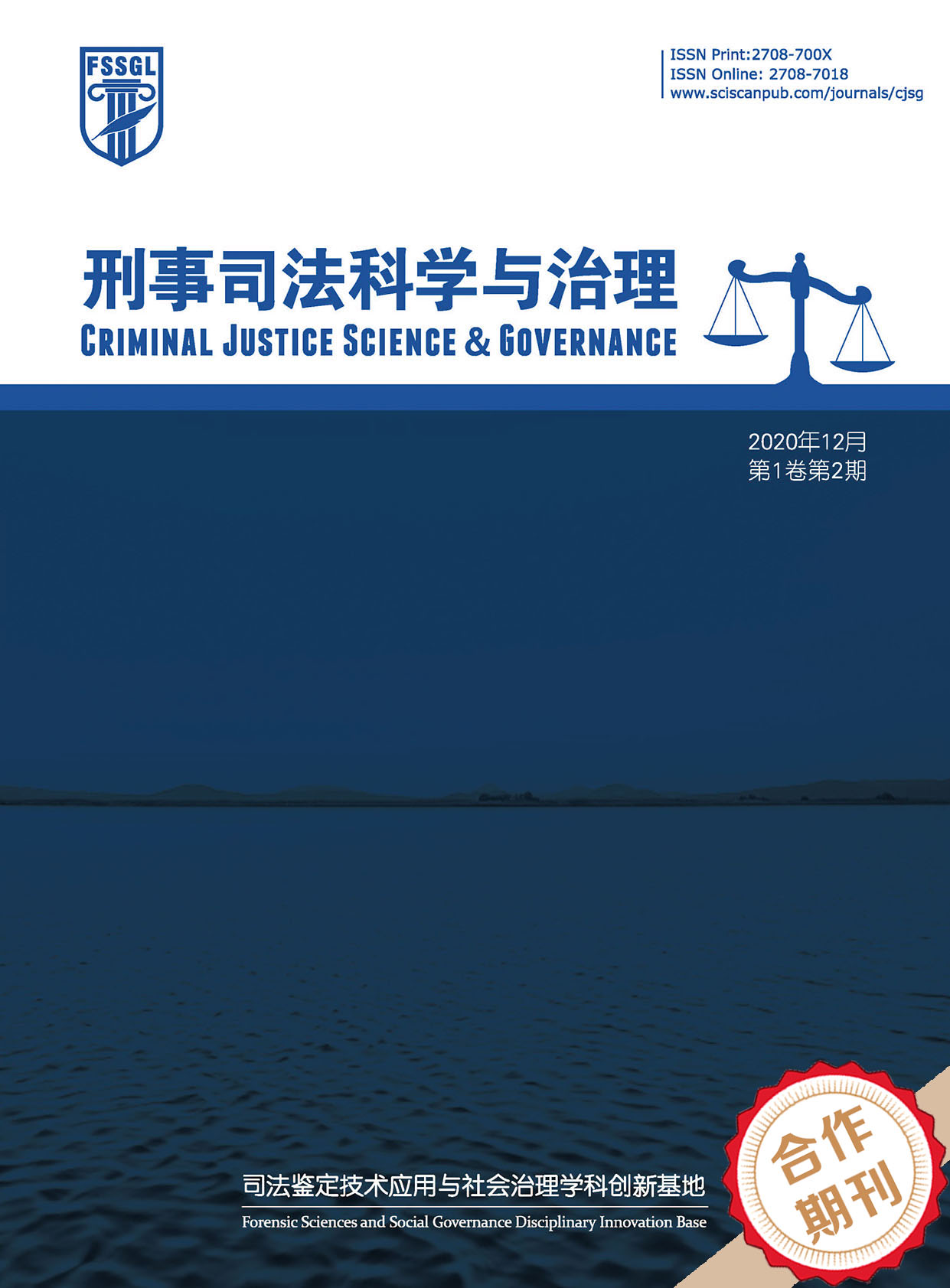Criminal Justice Science & Governance
社会控制视角下青少年犯罪影响因素研究
Research on the Influencing Factors of Juvenile Delinquency under the Perspective of Social Control
- Authors: 朱文畅
-
Information:
中南财经政法大学刑事司法学院,武汉
-
Keywords:
Juvenile delinquency; Social control; Certainty of punishment; Cointegration model青少年犯罪; 社会控制; 刑罚的确定性; 协整模型
- Abstract: In recent years, juvenile delinquency has become a social phenomenon that cannot be ignored. Takingthe social control theory as the analysis perspective and applying the research method of criminal economics,this study analyses the influence of the ratio of per capita disposable income of urban and rural families, the grossenrolment rate of high school, the detection rate of public security organs, the exemption rate of the court, and theproportion of the juvenile population to the total population on juvenile delinquency by setting up a cointegrationmodel using the juvenile delinquency data from the period of 1997 to 2021. The results show that the grossenrolment rate in high school, the detection rate of public security organs and the juvenile crime rate changepositively, the court exemption rate and the juvenile crime rate change negatively, and the proportion of juvenilepopulation in the total population does not have a significant effect on the juvenile crime rate. According to theconclusion of the model analysis, in order to reduce the juvenile crime rate, it can be achieved by optimising thesocial distribution system, improving the education level of juveniles, and insisting on the leniency and severity ofjuvenile justice. 近年来,青少年犯罪已成为不可忽视的社会现象。本研究以社会控制理论为分析视角,运用犯罪经济学的研究方法,以1997—2021年间的青少年犯罪数据为基础,通过建立协整模型,分析城乡家庭人均可支配收入之比、高中毛入学率、公安机关破案率、法院免刑率、青少年人口占总人口的比重对青少年犯罪的影响。结果显示,高中毛入学率、公安机关破案率与青少年犯罪率呈正向变化,法院免刑率与青少年犯罪率呈反向变化,青少年人口占总人口的比重对青少年犯罪率的影响不显著。根据模型分析结论,为降低青少年犯罪率,可以通过优化社会分配制度、提高青少年受教育水平、坚持青少年司法的宽严相济等措施来实现。
- DOI: https://doi.org/10.35534/cjsg.0501012
- Cite: 朱文畅.社会控制视角下青少年犯罪影响因素研究[J].刑事司法科学与治理,2024,5(1):97-104.
改革开放后,尤其是20世纪90年代以来,我国经济迈入高速发展期,国际交流的频繁化和国内产业的重构化带来了城市规模的快速扩张,城乡两极藩篱被打破,流动人口数量剧增,各行各业都涌现出活跃的发展潜力。但在经济欣欣向荣的背后,发展的代价却是对社会生态体系的挑战和重塑,社会保障普及率不足、主流价值理念丧失、亚文化入侵、社会资源分配不均等弱化了社会控制,带来了犯罪的大幅增加。1997年我国刑事罪犯人数为526312人,到2021年这一数字已上升至1714942人。为遏制犯罪增长,我国采取了提高公检法投入、增强犯罪惩罚的严厉性、加强社会管制等措施,进入21世纪以来犯罪增长率有所放缓,但犯罪率仍呈现出周期性波动的趋势。
在所有犯罪主体中,青少年犯罪越来越受到社会各界的关注。根据《中国法律年鉴》每年发布的数据,我国将25周岁以下(包括25周岁)的群体实施的犯罪行为称为青少年犯罪。图1反映了1997—2021年我国法院判处有罪的青少年人数及其占刑事罪犯总数的比例。从图中可以看出,青少年犯罪人数整体而言呈先增长后下降再增长的趋势,其中1997—2008年是我国青少年犯罪人数持续攀升的阶段,2008年之后呈逐年下降的态势,但在2017年触底之后再次出现反弹。青少年罪犯在刑事罪犯中的比重在1998年达到最大值39.39%,之后呈逐年下降的态势,于2002年达到极小值7.13%,往后4年间有所反弹,2006年达到极大值34.15%,之后再次呈现逐年下降的趋势,并于2017年达到最小值14.46%,从2018年开始出现轻微反弹趋势。结合我国21世纪两次“严打”来看,2001年的“严打”策略在一定程度上威慑了犯罪,带来的是2002年青少年犯罪人数及比重均明显下降,但2010年实施的“严打”策略威慑效果并不显著,2011年的青少年犯罪人数较2010年下降并不明显。

图1 1997—2021年我国青少年犯罪情况
综上所述,虽然我国青少年犯罪的绝对人数在25年间呈现周期性增减,但青少年罪犯占刑事罪犯的比例却从37.85%下降至16.53%,这种不一致性与我国的人口结构密切相关。21世纪以来,我国人口出生率整体下降,2022年人口自然增长率首次小于0,这意味着25周岁以下的人口比重在持续下降。在这样的背景下,仅凭青少年罪犯占刑事罪犯比重的下降并不能完全说明青少年犯罪治理向好。相反,自2018年以来青少年犯罪人数明显反弹。这不禁令人反思,在各级司法机关持续优化刑事政策以及政府部门定期开展“严打”的背景下,青少年犯罪为何得不到有效遏制?家庭、学校、政府等社会主体对青少年犯罪是否具有控制能力?
一、研究综述
20世纪60年代以来,犯罪研究在欧美国家掀起了浪潮,众多学者从法学、社会学、经济学、生理和心理学等角度出发,得出了诸多具有影响力的理论成果,对青少年犯罪研究具有深刻的指导意义。从社会学角度来看,Hershey在融合遏止理论和控制理论的基础上提出了社会控制理论,社会对青少年的行为具有外部控制作用,在社会的控制作用下,青少年不会实施犯罪行为,但随着时代变迁带来的社会防控失序,青少年对家庭和学校的依恋以及对法律和社会规范尊重的减弱,社会与青少年之间的纽带出现割裂,社会对青少年的控制作用开始削弱和瓦解,青少年的犯罪风险随之提高。在社会控制理论基础上,Sampson和Laub提出的非正式社会控制年龄分级理论强调社会关系的质量对青少年犯罪的影响。具体来说,青少年时期与家庭、同龄人和学校的社会纽带,以及成年时期与就业和婚姻的社会纽带,解释了青少年犯罪行为的变化,即纽带越强,犯罪和越轨行为就越少。此后,MayVartanian以及McCarthy关于父母依恋与青少年犯罪的研究得出了类似的结论,但是Zami的研究得出了家庭层面的社会控制对青少年犯罪没有影响的结论。与社会控制理论相对应的是Gottfriedson的自我控制理论。该理论认为,相较于社会因素而言,个人自我控制能力的高低对于青少年犯罪行为具有更高的解释力。Sacco以及CopsPleysier关于青少年个人因素与犯罪的研究得出了性别差异对青少年犯罪行为具有显著影响的结论,佐证了自我控制理论。具体来说,在相同情况下,男性青少年对犯罪的恐惧要远小于女性青少年对犯罪的恐惧。此外,Lemote的标签理论将青少年犯罪的原因归结于社会和司法制度的伤害。青少年之所以犯罪是因为社会和法律给他们贴上了“违法者”或“犯罪者”的标签,而被贴上此类标签的青少年有更大概率实施更激烈的违法犯罪活动。
进入21世纪,亚文化理论从心理学视角提出,与越轨同伴的交往、接触不良文化会增加青少年暴力犯罪的风险。Haynie的研究发现,在控制其他控制变量后,伴侣的犯罪行为与受访青少年的犯罪行为呈正相关,与越轨伴侣交往以及这种关系的激情正导致青少年以他们原本没有过的方式行事。SaraZedaker对亚利桑那州和宾夕法尼亚州14~19周岁犯有严重罪行的青少年进行数据搜集和访谈调研,研究发现,青少年在缓刑或假释期间处于恋爱状态可以在一定程度上减少其再犯的可能,伴侣的监控和双方的依恋可以降低犯罪风险。
犯罪是复杂多样的,除社会学和心理学外,经济学也产生了诸多理论成果。Becker首次将经济学理论应用于犯罪学领域,从成本收益理论和经济人假设的角度论证犯罪的成因,并提出只有当犯罪的预期收益大于犯罪的各项成本时,才会促使潜在的犯罪人实施犯罪。在Becker理论的基础上,Stiegler提出了“威慑理论”,即刑罚的确定性和严厉性能够威慑犯罪,防止罪犯实施更严重的罪行。
受国外犯罪学理论的启发,21世纪以来,我国学界基于本土国情也进行了一系列研究。彭国昌对全国16~35岁的青少年社区矫正对象进行了抽样调研,通过回归分析和路径分析,提出社会支持中的情感支持和支持利用度对罪错青少年的社区矫正有正向促进作用,而工具支持对其矫正存在显著抑制作用。杨江澜对14~18岁的青少年进行了抽样调研,通过回归分析发现,良好的亲子关系、完善的家庭功能、适度的父母监护和家庭支持有助于预防青少年犯罪。杨学锋对我国东部某市的中学生进行了抽样调研,运用logistic回归分析方法探究自我控制理论和社会控制理论对青少年越轨行为的解释力问题,结果表明自我控制理论和社会控制理论都可以显著解释调研对象的越轨行为,两者不存在替代关系。冯承才通过田野调查,对上海某社区青少年涉黑团伙“斧头帮”进行了访谈,提出亚文化的传播,即“混圈子”是街角涉黑涉恶青少年团伙形成的一大原因。赵卫国考察了越轨同伴交往对男性青少年攻击行为的影响,发现越轨同伴交往以道德推脱为机制,显著影响男性青少年攻击性行为。常进锋通过对青少年犯罪典型案例进行分析,提出累积性时间、突发性时间、选择性时间以及家庭、学校、社会的空间生产影响着青少年犯罪。此外,随着国内经济的快速发展,越来越多的学者将经济学的原理和方法应用于青少年犯罪领域。梁志娟、宋浩波通过理性经济人假设分析未成年人犯罪成因,认为未成年人也是理性经济人,他们实施犯罪行为是在衡量犯罪成本和收益的基础上进行的。杨莉芸提出城乡两极分化以及较低的惩罚成本会促使青少年人群犯罪。林维提出经济发展带来的城乡两极分化和贫富差距加大引发社会矛盾,增加青少年犯罪率。曹磊将未成年人犯罪成本分为实施成本、惩罚成本和机会成本,从犯罪成本的角度提出减少和预防未成年人犯罪的策略。
综上所述,国外关于青少年犯罪的理论成果较为丰富,但研究视角各异,各视角之间关联度不高,甚至存在冲突。而我国对于青少年犯罪的研究主要以社会冲突理论和亚文化理论为基础,多从青少年的个人心理、家庭环境、同伴交往等微观层面分析其犯罪原因,并提出防治对策,但从宏观层面研究青少年犯罪影响因素的文章数量较少,而且年代较为久远。本文尝试利用犯罪经济学的理论和分析方法,从社会控制的视角探究宏观的经济、社会和法律因素对青少年犯罪是否具有促进或抑制的作用。
二、模型构建
Becker认为,犯罪是个人基于理性人的角度考量犯罪的预期收益和成本,并且只有在犯罪的预期收益高于犯罪成本的情况下才会决定实施犯罪。然而,相较于25周岁以上的成年人,青少年并非完全意义上的“理性人”,他们仍处于一个特殊的成长时期,身心发展还不够成熟,社会化程度较低,认知水平和控制能力较弱,容易在周围环境的影响和诱导下冲动行事,从而导致青少年犯罪行为的产生。
一方面,青少年实施犯罪行为的动机形成过程与成年人存在较大不同,成年人的心理发育基本都较成熟,对社会规则和社会价值的认可度和遵守度更高,对社会的认识和了解也比青少年要更全面和更深刻。因此,他们在决定是否犯罪时,会考虑自身扮演的社会角色以及实际需求等理性的现实因素,其犯罪动机的形成过程是比较多重和复杂的。然而,青少年犯罪通常源于自我控制能力差、是非观念淡薄、易冲动等非理性因素,其动机形成过程具有突发性和冲动性的特征。在司法实践中,很多青少年犯罪都是一时冲动的产物,他们难以预见其犯罪行为会给他人和社会带来怎样的伤害,对自己将要面临的责任和刑罚也表现出无所谓的态度。另一方面,青少年罪犯由于其自身的特殊性,通常会选择防范意识和反抗能力较弱的同龄人或年龄更小的人作为犯罪对象,所以青少年实施犯罪的物质成本很低。此外,对于青少年,尤其是未成年人而言,现行的最低刑事责任年龄制度、《未成年人保护法》等司法政策要求公安机关和司法机关在办理未成年人犯罪案件中,要给予未成年人最大限度的保护。这些保障人权的政策反而可能对未成年人实施犯罪行为具有刺激作用,使得未成年人实施犯罪的机会成本和预期惩罚成本远远低于
成年人。
上述理论揭示了青少年这一群体的特性,而这一切特性归根究底源于组成这一群体的每一个个体以及其所处的环境的差异性。因此,单独从个体研究青少年犯罪难以全面观测其背后的成因机制。况且经济、社会和法律因素也不可能只针对某一个个体发挥效用。社会控制理论将青少年犯罪的控制主体按来源划分为家庭、学校和社会。结合青少年群体特性和数据可得性,分析模型包含城乡家庭人均可支配收入之比、高中毛入学率、公安机关破案率、法院免刑率、青少年人口占总人口的比重等因素。
本文通过利用多元时间序列数据,建立协整模型,实证检验家庭经济能力的差距、公安机关的破案率、审判机关的免刑率、青少年高中毛入学率、青少年人口占总人口的比重等因素是否是青少年犯罪的影响因素。具体模型如下:
Yt=β0+β1*X1t+β2*X2t+β3*X3t+β4*X4t+β5*X5t+ut
其中:因变量Yt表示对应年份我国青少年犯罪率;X1t表示对应年份的城乡家庭人均可支配收入之比;X2t表示对应年份的青少年高中毛入学率;X3t表示对应年份我国公安机关的破案率;X4t表示对应年份我国审判机关生效判决中的免刑率;X5t表示对应年份我国青少年人口比重;ut表示随机误差项。
三、研究过程与结论分析
(一)数据来源和变量说明
本研究模型中所有变量的数据均来源于《中国统计年鉴》和《中国法律年鉴》,考虑到数据的可得性和完整性,选择1997—2021年的数据进行分析。
模型中的因变量Yt为对应年份我国青少年犯罪率。《中国统计年鉴》中的“人民法院审理刑事案件罪犯情况”一表中统计了历年25周岁以下(含25周岁)的刑事罪犯人数,同时参考曾鹏教授关于犯罪率的计算方式,结合数据的实际情况,本文用“0~25周岁每万人犯罪人数”来计算对应年份的青少年犯罪率。模型中的自变量主要包括城乡家庭人均可支配收入之比X1t,用来反映家庭的经济地位差距;青少年高中毛入学率X2t,反映青少年与学校之间的纽带联系;公安机关破案率X3t和审判机关免刑率X4t反映我国刑罚的确定性和严格性程度。基于威慑理论和现有文献,提高刑罚的确定性比提高刑罚的严厉程度更能有效震慑犯罪行为,进而提升犯罪的预期惩罚成本。其中破案率采用对应年份全国公安机关破获的刑事案件数量占立案数量的比重来衡量,免刑率则采用对应年份全国法院有效宣判人数中宣告无罪和不受刑罚的人数占比来衡量;青少年人口占比X5t采用对应年份全国0~25岁人口占总人口的比重来衡量。上述因变量和自变量的描述性统计见下表1。
表1 变量描述性统计
| 变量 | 观测值 | 均值 | 标准差 | 最大值 | 最小值 |
| Y | 25 | 6.06 | 1.49 | 8.95 | 3.54 |
| X1 | 25 | 2.83 | 0.22 | 3.14 | 2.47 |
| X2 | 25 | 68.89 | 20.52 | 91.4 | 40.60 |
| X3 | 25 | 43.97 | 9.53 | 72.6 | 31.27 |
| X4 | 25 | 1.75 | 0.40 | 2.29 | 0.51 |
| X5 | 25 | 34.19 | 4.13 | 42.06 | 26.41 |
(二)单位根检验
时间序列数据在进行分析前,首先需要检验数据的平稳性。如果时间序列数据是不平稳的,可能会导致自回归系数的估计值向左偏向于0,t检验失效,也可能会导致变量之间出现假相关或者假回归的情况。因此,本文采用传统的ADF检验法对因变量和5个自变量的平稳性进行检验。
通过ADF检验后发现,除了青少年犯罪率(Y)和公安机关破案率(X3)这两个变量属于平稳数列,可以通过5%显著性水平下的单位根检验外,其他变量都无法通过5%显著性水平下的单位根检验,属于非平稳数列。因此,接下来需要对各个变量进行一阶差分后再进行单位根检验。
表2 变量单位根检验
| 变量 | ADF检验P值 | 平稳性 |
| d2.y | 0.0000 | 平稳 |
| d2.X1 | 0.0000 | 平稳 |
| d2.X2 | 0.0007 | 平稳 |
| d2.X3 | 0.0000 | 平稳 |
| d2.X4 | 0.0000 | 平稳 |
| d2.X5 | 0.0000 | 平稳 |
由表2可知,经过二阶差分后,所有变量经过ADF检验后,P值均小于0.05,说明变量通过5%的显著性水平检验,即所有数列经过二阶差分后都趋向于平稳,符合接下来协整检验的前提。
(三)协整模型
在数列满足平稳性的基础上,要根据信息准则确定变量的滞后阶数,同时确定模型中变量的个数。一方面,如果模型中的变量太少,就很可能遗漏许多信息,进而导致模型的解释能力不足;另一方面,如果模型中的变量太多,就会导致信息重叠,也会影响模型的解释能力。根据检验结果,并结合实际情况,确定模型的最优滞后阶数为2阶,对变量进行协整回归,得到结果如表3所示。
表3 协整分析结果
| 变量名 | 估计值 | 标准差 | Z | P>|Z| | 95%置信区间 |
| X2 | —0.14 | 0.19 | 0.76 | 0.032 | [—0.22,0.51] |
| X3 | —0.01 | 0.03 | 0.40 | 0.035 | [—0.05,0.07] |
| X4 | 1.73 | 1.94 | —0.89 | 0.045 | [—5.54,2.07] |
| X5 | 0.96 | 0.25 | —3.90 | 0.579 | [—1.46,—0.47] |
| —cons | 7.46 | / | / | / | / |
(四)结论分析
在研究家庭经济地位差距时,本文选择将城乡家庭人均可支配收入之比作为代理变量,但在协整模型中,城乡家庭人均可支配收入之比对于青少年犯罪率的影响趋向于0,影响几乎可以忽略不计,原因可能包括两个方面:一是城乡家庭人均可支配收入之比能否作为家庭经济地位差距的代理变量有待商榷,其在目前的文献中应用较少,主要反映的是城乡家庭之间的收入差距,无法反映城镇家庭之间和农村家庭之间的内部差距;二是模型中的时间序列数据跨度只有25年,样本容量较为有限,可能在一定程度上影响了模型的解释能力。尽管在模型中家庭经济地位差距对青少年犯罪的影响没有体现出来,但在司法实践中,因为家庭经济能力差而选择犯罪的青少年不在少数。根据Becker的理论,经济能力越差、收入越低的人,其犯罪的机会成本就越低,相对而言就越有可能实施犯罪行为,因此不能忽视经济地位差距对青少年犯罪的影响。
在研究学校对青少年的社会控制时,本文选用青少年高中毛入学率来衡量其受教育水平,分析结果显示,高中毛入学率的提高会在一定程度上降低青少年犯罪率,协整模型支持滞后2阶的回归结果,具体来说,某一年度(大于等于1999年)两年前的高中毛入学率提高,那么在当年青少年犯罪率就会出现一定程度的下降。一方面,从社会控制的角度分析,受教育水平的提高有助于提升个人的整体素质,进而提升社会的文明程度,而文明程度越高的社会,其对公民的控制力和约束力就越强,更能促使公民遵守社会秩序和法律规范,抑制犯罪欲望;另一方面,从机会成本理论来看,青少年初中毕业后,其所受的教育和掌握的知识技能难以支撑其从事高薪职业,收入不足会提高其犯罪的机会成本,增强其犯罪倾向。相反,顺利进入高中的青少年能够进一步接受学校教育,未来更有可能进入高等院校深造,提高自己的学识修养和知识水平,他们在毕业后更容易获得选择理想职业的机会,拥有更高的预期工作收益,从而降低其犯罪的机会成本。
刑罚的确定性,代理变量为模型中的破案率和免刑率。从分析结果来看,公安机关破案率和审判机关免刑率在协整模型中支持滞后2阶的回归结果,即某一年度两年前公安机关破案率的下降、审判机关免刑率的提升会提高青少年犯罪率,这也印证了威慑理论中刑罚的确定性可以震慑犯罪的观点。
模型中青少年人口占总人口的比重对青少年犯罪率的影响并不显著。在现实社会中,我国人口自然增长率持续下降,青少年人口占比也不断降低,但近年来青少年犯罪人数又呈现上升的趋势。因此,我国青少年人口比重的降低并不意味着青少年犯罪治理前景向好。相反,老龄化社会带来的是养老负担的加重和生活成本的提高,沉重的社会负担在无形中助长了青少年犯罪的预期收益和机会成本,特别体现在财产类犯罪上,从2017年到2021年的短短5年间,因侵财犯罪受到法院刑事处罚的青少年人数从69335人上升到82732人。
四、政策建议
(一)优化分配制度,缩小收入差距
根据Becker的理论和结论分析,分配不公平和收入差距的扩大是导致犯罪行为的重要因素。虽然本文的模型未能反映城乡收入差距对于青少年犯罪率的影响,但模型并不能代替社会现实,经济地位的差距不可避免地给青少年带来心理上的落差,尤其是青少年在心理本就不够成熟的情况下,丰厚的预期收益很容易诱使他们实施犯罪行为。从数据来看,我国经济发展与分配制度不协调现象越发突显,城乡收入差距没有明显改变,虽然政府也采取了诸多措施改善收入分配,但从结果来看,效果并不明显。因此,要减少青少年犯罪,必须缩小不同群体收入水平的“剪刀差”,尤其是要增加底层青少年人群的收入,减轻他们的生活压力,创造良好的就业岗位,降低经济地位差距给青少年心理上带来的落差感和挫折感,从而缓解因分配不公带来的社会矛盾和冲突,这样可以在一定程度上减少青少年因分配不公和心理落差而实施的犯罪行为。
(二)提高青少年受教育水平,促进教育体系多元化
青少年高中毛入学率的提高可以一定程度上减少青少年犯罪率,这说明在我国的社会条件下,学校对青少年是具有社会控制作用的,而在初中毕业后就过早进入社会的青少年,学校对其的控制能力会持续减弱,因而更容易走上犯罪的道路。所以,现阶段提高我国青少年高中入学率是非常有必要的。一方面,要合理分配教育资源,我国教育水平整体上呈现东部高于中西部、城市高于农村的特征,因此教育支持的重点应放在内陆和农村地区,尤其是要增强农村家庭的教育意识,让更多农村留守青少年和家境困难的青少年有机会接受高中教育和高等教育,避免他们因家庭教育理念落后或减轻家庭经济负担而过早进入社会,进而在心智尚不成熟的情况下出现行为偏差。另一方面,要推进我国教育体制多元化和专业化建设,不仅要扩大教育覆盖范围,更要充分发挥各类教育的功效,增强高中和高等院校学生的专业功底和学识修养,强化各类职业技术院校学生的技能培训和考核,促进学校教育与社会需求的融合,提高青少年的就业能力和社会适应能力,避免因缺乏谋生技能而走向犯罪的道路。
(三)坚持青少年司法的宽严相济
目前我国对青少年犯罪的治理,既要保证刑罚的确定和严格,又要体现出人文关怀,符合社会发展需要。因此,一方面,要充分总结司法实践经验,刻画青少年罪犯的年龄、犯罪动机、犯罪类型、犯罪地点等特征因子,从而有针对性地分配司法资源,将司法支出的重点放在人口聚集度较高、社会治安较差的地区,重点打击侵犯财产类犯罪、街角团伙犯罪等青少年群体多发的犯罪类型,对“累犯”“惯犯”要提高刑罚力度,提升司法的威慑力,杜绝一切投机行为。对初犯、从犯或是被胁迫参与犯罪的青少年以说服、教育、疏导为主,可以根据实际情况适当减轻刑罚,并联合家庭、学校、社区等机构及时矫正其犯罪行为,在司法资源有限的前提下尽可能做到效益最大化。另一方面,相较于成年人,青少年犯罪对社会造成的实际危害较小,以财产类犯罪为主,通常数额不高,如果在罪行比较轻微的情况下,可以在诉讼过程中适当引入青少年犯罪和解程序,让犯罪青少年与受害者进行积极的对话,向受害方道歉,争取对方的谅解,并提出相应的赔偿方案,这样做可以在一定程度上削弱或避免犯罪标签给青少年重新融入社会带来阻碍,有利于犯罪青少年行为的矫正与自我反省。
五、研究不足
首先,本文选取的样本为1997—2021年共25年的数据,时间跨度较短、样本容量较小,检验结果可能存在一定偶然性,普适性有所欠缺;其次,本文在选取代理变量时,受数据可得性、自变量个数限制等因素影响,用城乡家庭人均可支配收入之比作为经济地位差距的代理变量、用高中毛入学率作为学校社会控制能力的代理变量,在变量选取方面存在较强的主观性,所选取的代理变量可能无法完全反映出经济地位差距和学校的控制能力,在一定程度上影响了模型的解释能力;最后,本文受可得数据限制,未能分析出上述因素对青少年犯罪率影响的中间作用机制,这有待进一步研究。
















